A 2025 poll conducted by Mission Roll Call revealed that 74% of veterans would use an online healthcare portal if one were available, a resounding signal of demand for streamlined, digital-first care access.
 From portals and apps to telehealth and peer platforms, digital tools have the potential to reshape mental health care for millions. This article explores what’s available, trustworthy, and shaping the future of veteran wellness.
From portals and apps to telehealth and peer platforms, digital tools have the potential to reshape mental health care for millions. This article explores what’s available, trustworthy, and shaping the future of veteran wellness.
The Veteran Mental Health Landscape
Veterans frequently navigate mental health challenges such as PTS, depression, anxiety, and the stress of reintegration into civilian life. Roughly 20% of veterans from Iraq and Afghanistan experience PTS or depression, and just under half of all veterans receive needed treatment.
Mission Roll Call emphasizes that stigma, isolation, and complex systems often compound these struggles. The ACCESS Act polling underscores a clear veteran preference for digital tools that make care easier and more accessible.
Online Healthcare Portals
One of the clearest starting points has been online healthcare portals. Digital platforms promise convenience, privacy, and agency. The VA’s Access to Care platform offers transparency to veterans navigating care choices.
Additionally, in 2025, the VA eliminated the secondary-approval hurdle for community care referrals, speeding access to external providers under the MISSION Act. Together, these changes point toward a system that is simpler and more responsive.
For veterans who don’t qualify for or can’t easily access VA care, MyRX Access Plus has emerged as an additional option. The platform connects veterans and their families to affordable prescriptions and healthcare resources outside the VA, aligning directly with the 74% who say they would use an online portal if available.
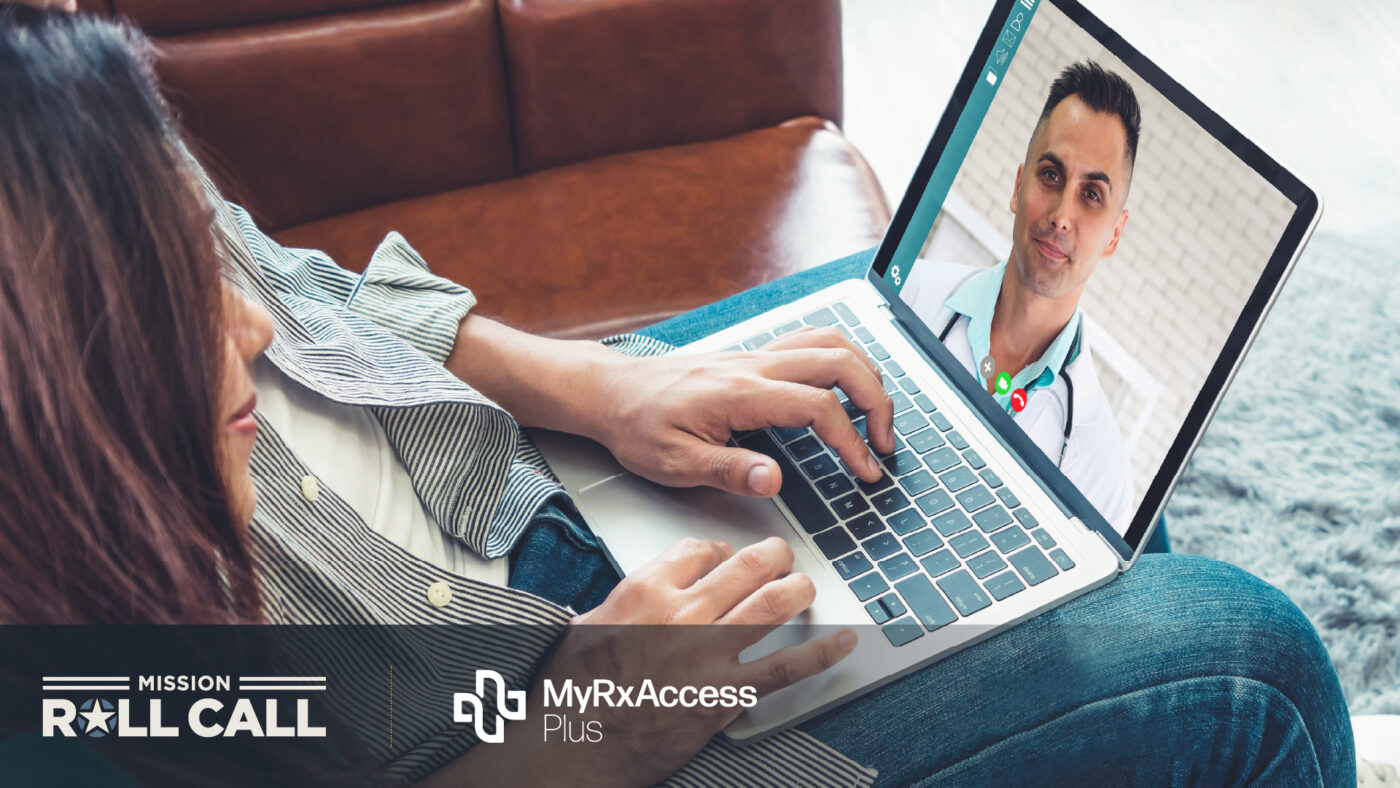
Mental Health Apps
Some of the most widely used tools live right on a smartphone. From helping manage trauma symptoms to coping with anger, apps such as PTSD Coach, Calm, Headspace, and others offer personalized support. Their credibility hinges on clinical backing, research evidence, and robust privacy standards. Explore this list of Mental Health and Behavioral Therapy apps for veterans and their families.
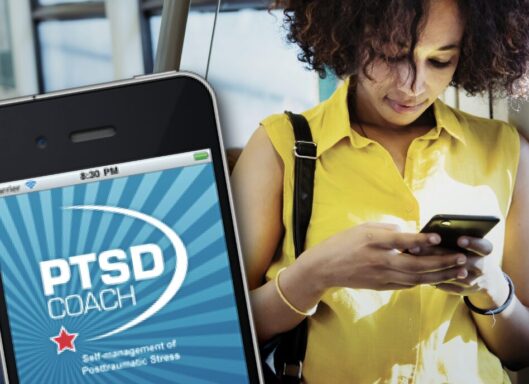
Beyond portals, a growing number of technology tools are empowering veterans with easy access to providers, self-help, and care tracking, which is particularly appealing to those in rural or underserved areas. Digital care doesn’t replace human connection—it extends it, making support possible at moments when veterans need it most.
In case you didn’t know, the VA has an App Store that provides access to over 40 web and mobile apps designed for Veterans, their families, and VA providers. These apps cover a range of services, including health and wellness, benefits information, symptom tracking, and tools to facilitate communication with VA providers. You can find these apps, which include native apps for iOS and Android and web apps accessible through a browser, at mobile.va.gov/appstore.
Peer Support Online
Technology also provides spaces where veterans can connect with one another. Online forums and moderated peer platforms foster a sense of belonging and mutual understanding. Veterans often find strength in shared stories and lived experience. A few examples of peer platforms to check out are:
- America’s Warrior Partnership (AWP), which offers a national network of support and resources that includes peer-to-peer connections.
While primarily an advocacy organization, Mission Roll Call plays a unique role in amplifying veterans’ mental health needs. Through polling, storytelling, and media outreach, MRC creates a sense of community by bringing attention to struggles like suicide risk and care access.
Supporting Veteran Families and Caregivers
Behind every veteran navigating mental health challenges is often a circle of support: spouses, partners, children, parents, and caregivers–whose needs are frequently overlooked. These individuals are critical to long-term recovery and wellness, yet they, too, can face emotional strain, burnout, and a lack of resources. Some digital platforms are beginning to close this gap.
- VA’s Caregiver Support Program offers online resources, peer mentoring, and telehealth coaching for those supporting post-9/11 veterans.
- Military OneSource provides 24/7 access to confidential counseling, educational webinars, and caregiver-specific content.
- Apps like MoodCoach and PTSD Family Coach are designed to help loved ones understand symptoms, manage stress, and provide appropriate support without sacrificing their own well-being.
Inclusive technology matters because wellness rarely exists in isolation. Tools that extend access to families and caregivers can help create a more sustainable and informed support network.
Looking Ahead: What’s Next in Digital Veteran Wellness
Looking ahead, the future of digital wellness for veterans is filled with hopeful possibilities. Tools are beginning to offer gentle, everyday check-ins that create small moments of connection that can make a big difference before things become overwhelming.
Virtual reality and biofeedback – a process that uses your body’s own signals like heart rate and body temperature to bring about healthy changes – are also stepping in, helping veterans process difficult experiences in safe, controlled ways while staying in tune with how their bodies respond to stress. And on the horizon is something many have long hoped for: a more seamless, personalized experience, where the tools veterans use can actually talk to each other, making care feel less like a maze and more like a path forward.
Conclusion
The demand is clear—three out of four veterans say they would use digital healthcare tools if available. For providers and advocates, the challenge is ensuring tools are accessible, trustworthy, and responsive to veteran needs.
Digital tools aren’t a foolproof solution; connectivity issues, device access, and tech literacy can all hinder adoption. Emerging hybrid models, combining digital tools with in-person support and partnerships between the VA and community organizations, may help bridge these gaps.
Whether you’re a veteran navigating your own path to wellness, a loved one standing beside them, or someone working to build better tools, there’s a place for you in this growing digital ecosystem.
Veterans can find strength and support in the trusted apps and telehealth services already at their fingertips. Families and caregivers are not forgotten; many platforms offer guidance and resources to help you care for those you love while also caring for yourself. And for those developing the next wave of solutions: listen closely to veteran voices, and build with empathy, security, and the full circle of support in mind.
For many veterans, service dogs are more than companions; they’re a quiet kind of safety. That has been true for Mission Roll Call’s own Taamir Ransome, whose path to service dogs began years before he joined the MRC team.
Taamir enlisted in the Army in October 2001, only weeks after the attacks of September 11. What started as a technical track in radar repair quickly shifted into combat deployments with the 82nd Airborne, then into explosive ordnance disposal (EOD). He eventually earned a place in a special mission unit, becoming the first Black Tier 1 EOD operator in history. Over the course of 22 years, he deployed repeatedly, survived blasts and crashes, and carried the physical and invisible weight of a long career in special operations. In 2021, after surgery to rebuild his foot, he medically retired.
Transition was harder than expected. “When you get out of the military, you lose your adrenaline, your purpose, and your tribe,” Taamir said. “I was doing pretty bad.” Therapy helped, as did friends who made sure he wasn’t isolating. The steadying force, though, came with a service dog.
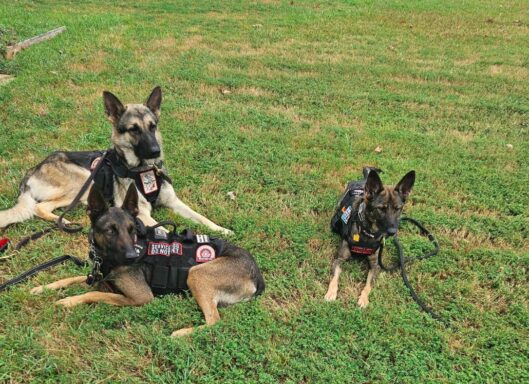
His first dog, Dimos, was trained and placed through a nonprofit that works with the special operations community. The bond was immediate. “He makes me feel safe. He watches my back. I don’t have to be wound so tight because I know he’ll give everything for me.” Hypervigilance eased. Structure returned. And for the first time in years, Taamir felt comfortable showing up in crowded community spaces—school dances, baseball games, local events—with Dimos at his side.
Living with a service dog also revealed how many barriers remain for veterans. Taamir explained that misunderstandings about rights are common, from being asked for “paperwork” that doesn’t exist to skepticism about service dogs trained for PTS or anxiety. The VA does not provide consistent coverage for service dogs outside of narrow categories, leaving many veterans to rely on nonprofits or pay out of pocket. Education and access remain the largest gaps.
That’s why legislation like the SAVES Act matters. The bill is designed to make it easier for veterans to connect with accredited programs and receive the support they need, especially for conditions like post-traumatic stress. If passed, it would help address the lack of clear pathways Taamir and so many others have faced, creating consistency across the system so veterans aren’t left to navigate alone.
Rather than stop at his own experience, Taamir went a step further and began training dogs for others. Together with his son Mario, he works with German Shepherds, Giant Schnauzers, and other breeds, teaching obedience, stability, and readiness for public spaces. The work has become both therapy and connection. “Because of the dogs, me and my son are probably the closest we’ve ever been. Motorcycles, cars, dogs—that’s our thing.”
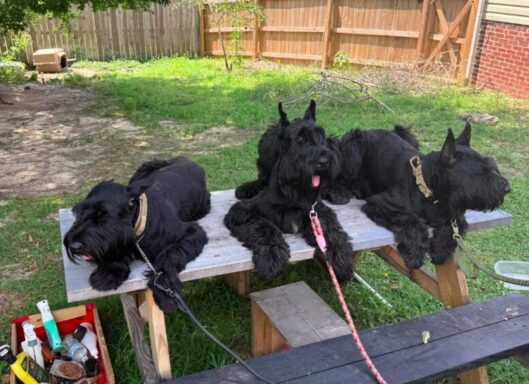
Today, Taamir manages a full pack: Dimos, Aries, Atlas, and Thanos, along with a steady stream of dogs he and Mario train for veterans and neighbors. Each one learns balance—discipline and reward, caution and calm. The goal is the same every time: to have dependable partners who rise to protect when called upon and bring calm when the moment passes.
Taamir’s role at Mission Roll Call now gives him the chance to amplify what he has lived—sharing his story, training alongside his son, and advocating for other veterans who could benefit from the same support. If you ask him what service dogs provide, he’ll keep it simple. Fewer nightmares. A reason to get up and keep a routine. A sense of safety that opens the door to being social. Stronger ties with his son, and the satisfaction of training dogs that go on to serve other veterans.
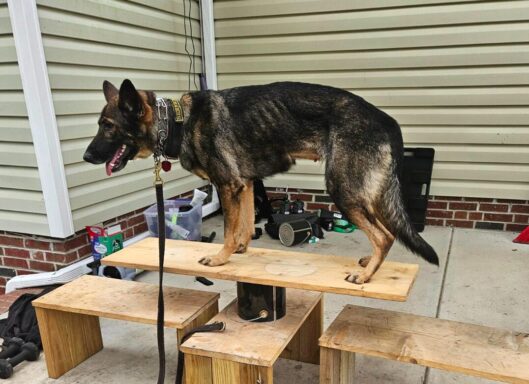
He also carries with him a favorite line about their nature: “Dogs have beauty without vanity, force without insolence, bravery without ferocity, and all the virtues humans have without any of the vices.”
On National Service Dog Awareness Day (Sept. 20), we celebrate veterans like Taamir who have found stability and purpose through service dogs, and the organizations and legislation working to expand access. Share your story with Mission Roll Call and help us build the awareness and action needed to ensure every veteran has a clear path to a trusted partner at their side.
September 7–13 marks National Suicide Prevention Week, a time to raise awareness, break down stigma, and take meaningful steps toward preventing suicide in our communities. For our nation’s veterans, this week carries special urgency. The mental health crisis among those who’ve served continues to deepen, and it’s one we must face together.
Veteran Suicide Is a National Crisis
The numbers are sobering:
- According to the VA’s 2024 annual report, an estimated 17.6 veterans die by suicide every day.
- But other research suggests the true number could be significantly higher. A study by America’s Warrior Partnership, Operation Deep Dive, estimates as many as 44 veteran suicides per day when accounting for drug-related deaths and self-injury mortality.
- That means we could be losing more than 16,000 veterans each year—more than all U.S. combat deaths since Vietnam.
Behind every number is a person. A family. A story that ended too soon.
Understanding the Risk
Transitioning out of the military can be one of the most vulnerable times in a veteran’s life. Studies show that the first two years after leaving active duty are especially high-risk due to challenges like isolation, loss of identity, and limited access to care.
There are also alarming disparities across groups:
- Male veterans are 60% more likely to die by suicide than civilian men.
- Women veterans face a 92% higher suicide rate than civilian women.
Post-traumatic stress continues to affect a significant portion of the veteran community. About 15% of Iraq and Afghanistan veterans experience PTS in any given year, and roughly 1 in 3 will experience it at some point in their lifetime.
Access to care remains a major barrier as well. Nearly 45% of veterans report long wait times or delays in receiving health care through the VA. In some areas, wait times for mental health care exceed 50 days.
Progress Is Happening — But It’s Not Enough
The recent passage of the Elizabeth Dole Act has been a step in the right direction. It expands resources for employment, disability claims, mental health care, and support for the 7.8 million caregivers who walk alongside our veterans every day.
But policy alone can’t solve this crisis. It takes all of us veterans, families, communities, and advocates working together to ensure no veteran is left behind.
Support Starts Here
If you or someone you know is struggling, please know you’re not alone.
- Veterans Crisis Line: Dial 988 then press 1
- Veterans Resource Directory
- Mission Roll Call Suicide Prevention Page
Together, we can build a future where no veteran feels that suicide is their only option.
Get Involved: Ride & Run 4 Their Lives with HBOT4Heroes
This National Suicide Prevention Week, MRC is teaming up with HBOT4Heroes to help turn awareness into action through two powerful events that support veteran suicide prevention efforts and honor those we’ve lost:
Ride 4 Their Lives with Raging Bull Harley-Davidson
Sunday, Sept. 7 | Durham, NC
Kick off National Suicide Prevention Week with a scenic group ride to the Orange County Veterans Memorial.
- Registration at 10 AM | Kickstands up at 11 AM
- Riders: $25 pre-registration | $30 day-of
- Raffle prizes, community vendors, and more
Register here: hbot4heroes.org/events/ride-4-their-lives
Run 4 Their Lives 5K
Saturday, Sept. 13 | American Tobacco Trail
Run, walk, or roll — every step you take honors the 44 veterans we lose to suicide each day and helps protect the living.
- Family-friendly and fully accessible
- All proceeds support suicide prevention outreach and treatment
Register here: hbot4heroes.org/events/5k-run4theirlives
Can’t ride or run? You can still stand with us.
- Donate.
- Spread the word.
- Volunteer.
- Share your story.
National Suicide Prevention Week reminds us that hope is real, and help is out there. We honor those we’ve lost by showing up for one another, speaking out, and standing together in the fight for life.
Let’s ride. Let’s run. Let’s rise for their lives.